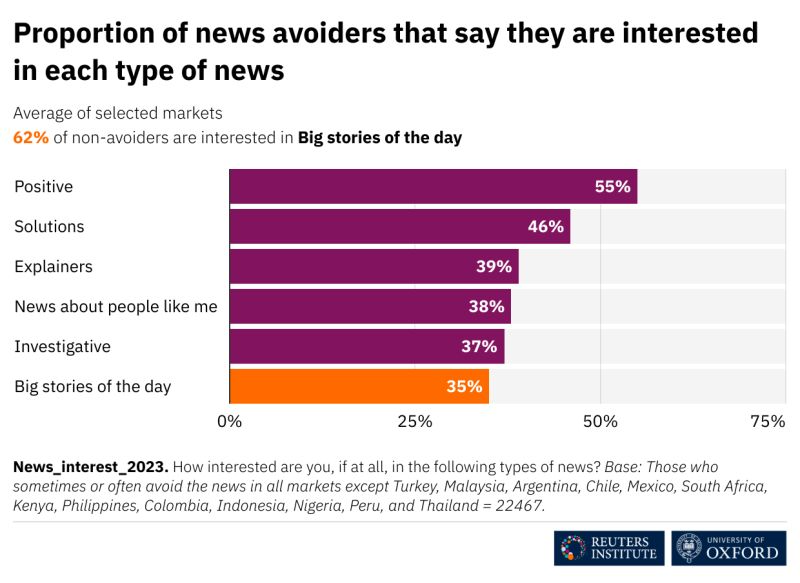How Solutions Journalism Rebalances the News
There's a growing body of research on how readers respond to stories about solutions.
Banner photo: 2023 Nigeria Health Watch Sojo Close Out Event
It’s clear the current news paradigm is out of step with the kind of information people hope to read more of. Simply put, solutions journalism is what audiences want. Even news avoiders surveyed for the Reuters Institute 2023 Digital News Report were "more likely to say they are interested in positive or solutions-based journalism and less interested in the big stories of the day."

Focus-group discussions about communities’ relationship with the news media in and around Philadelphia in late 2017 and early 2018 surfaced a desire to see more solutions-oriented journalism. This was echoed in 2023 by Irene McKisson, a co-founder and principal executive of the solutions-oriented newsroom Arizona Luminaria, who said that before the outlet was established, "We heard people, unprompted, tell us that they wanted to understand what solutions existed for problems in their community."
In 2017, researchers at the Institute for Applied Positive Research found that solutions-oriented reporting made people feel less anxious, more energized and more connected to the community. Audiences also reported more willingness to talk about the issues, collaborate with others, and hold officials in positions of power accountable for change.
In 2020-21, we commissioned SmithGeiger, a leading media research firm, to study the impact of solutions journalism. SmithGeiger talked to more than 600 local news consumers in six television markets across the country to understand the impact of a solutions journalism approach compared with the more conventional "here’s a problem we’ve uncovered" story. SmithGeiger found audiences rated solutions stories as more interesting and important than conventional stories. Also, after watching solutions stories, they were more likely to take action: talk to others about the story, search for more information online and feel inspired to get involved. The findings did not vary by geography or demographics — or, notably, by political ideology. The stories also built loyalty to the stations that aired them.
Time and again, research proves that offering audiences solutions gives them both a reason to engage in collective action and — crucially — hope that it will work. Beyond kindling renewed faith in the solvability of social crises, solutions journalism creates audiences who are better informed and more willing to discuss issues with their community. A study conducted among readers of the Chattanooga Times Free Press found that public discourse (measured via X, formerly known as Twitter) increased following the publication of a solutions series.
These benefits are only going to increase in the future, as solutions journalism resonates especially well with millennial and Gen Z audiences. According to the News Literacy Lab’s 2023 Impact Report, a media literacy school curriculum that included examples of solutions journalism "has the potential to make students more hopeful about society and the world, while also enabling them to take a more balanced approach in terms of their exposure to news."
The Problem in a Nutshell
Across the world, more than 30% of the population admits to actively avoiding news. Media scholars Karen McIntyre and Meghan Sobel explain that two major causes of news avoidance are psycho-physical numbing (the phenomenon that makes it difficult to feel that large-scale suffering in distant places is real) and compassion fatigue (the idea that the more suffering we are exposed to, the harder it is to feel its impact).
News, especially U.S. media, has a bias toward the negative. For example, in a study comparing U.S. news coverage of COVID-19 in 2020 with international coverage of the pandemic, the economics professor Bruce Sacerdote, along with two other researchers, found that 87% of national U.S. news coverage of COVID was negative, compared with 51% of international news coverage (meaning that national U.S. news was failing to update audiences about improvements in care, vaccinations, and falling case and fatality rates). That relentless negative coverage has a significant impact on how audiences engage with media: In a global survey of news audiences for the 2019 Reuters Digital News Report, one-third of respondents said they "often or sometimes" avoid the news because it has a negative impact on their mood.
But solutions journalism is different from the problem-centric reporting that leads to these forms of emotional burnout.
The Sustainability Case for Solutions Journalism
The pursuit of solutions-oriented reporting also offers a paradigm shift that can benefit the industry’s sustainability.
Solutions journalism is good for public trust in the media. Whereas a 2021 Pew Research Center survey found 42% of U.S. adults have little or no trust in the information that comes from national news organizations, research conducted by the media research firm SmithGeiger shows 83% of respondents said they trusted a solutions journalism story. By comparison, only 55% said the same about a problem-focused story on the same topic.
That increase in public trust is compounded by evidence that shows consumers of solutions journalism are more engaged, which opens the door for people to provide financial support. Solutions coverage creates readers who are more likely to click through headlines to read the full story, spend more time on the news site, and are more likely to return to the website in the future. In fact, one outlet that shifted to a solutions (or constructive) journalism model noticed a 29% increase in subscribers. When The Trace, a publication focused on gun violence, launched a newsletter, The Trajectory, highlighting potential solutions, the newsletter received "a much bigger response" than expected; about half the newsletter’s subscribers had never signed up for other products from The Trace.
This is part of a larger trend of news producers shifting their work to address the growing news avoidance and distrust of audiences around the world. The 2023 Reuters report stated that some news organizations "are looking to make news more accessible for hard-to-reach groups, broadening the news agenda, commissioning more inspiring or positive news, or embracing constructive or solutions journalism that give[s] people a sense of hope or personal agency."
SJN’s Impact Database provides growing evidence that solutions stories and foregrounding a solutions-oriented editorial approach can help newsrooms generate revenue. Here are a few highlights:
In a study of SJN’s pilot Revenue Project, which ran between 2020-21, the academics Nicole Dahmen and Jacob Nelson found that "journalists remain committed to solutions journalism despite [...] obstacles, both because they find it compelling and because of its potential for revenue in the form of foundation funding." Nine of the 12 participating newsrooms generated $1.5 million in new revenue related to solutions journalism. Separate research, commissioned by SJN, strongly indicates that solutions journalism delivers the kind of loyal and engaged audience that is more likely to enter reader revenue programs to support journalism.
Societal Impact of Solutions Journalism
Beyond the beneficial effects on audiences and the promising revenue outcomes solutions journalism can bring to newsrooms, this editorial approach has wider ripple effects, proving it can be a vector for societal change. Here are some examples:
